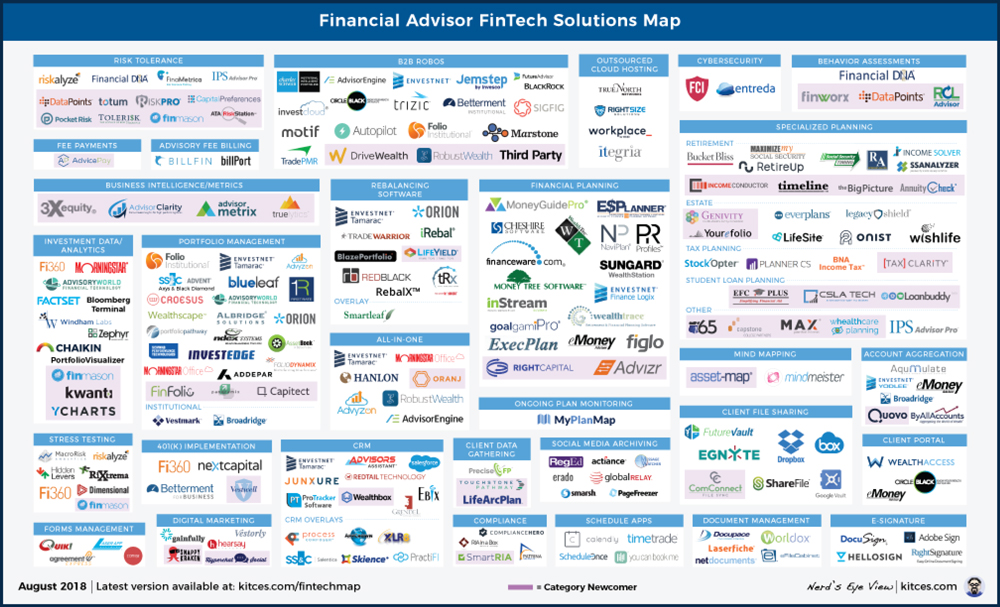Michael Kitces on the fate of robos, Yelp help and recent fintech competitions, products

This month's edition of the Latest News in Financial Advisor #FinTech kicks off with big news about high-profile robo-advisers pivoting to B2B products for advisers.
Welcome to the August 2018 issue of the Latest News in Financial Advisor #FinTech — where we look at the big news, announcements, and underlying trends and developments that are emerging in the world of technology solutions for financial advisers and wealth management!
This month’s edition kicks off with the big news that, after years of warning that robo-adviser growth rates were slowing and seeing many high-profile robo-advisers pivot to become B2B solutions for advisers, some of them are beginning to outright shut down, with early robo-adviser Hedgeable (founded in 2009) withdrawing its investment adviser registration to manage portfolios as its founders move on to new blockchain endeavors, and WorthFM permanently terminating, as its related DailyWorth media site is sold (without the WorthFM robo-adviser attached) to personal finance media personality Jean Chatzky.
From there, the latest highlights also include a number of interesting adviser technology announcements, including:
• Notwithstanding guidance that it’s permissible for clients to leave reviews for advisers on Yelp, the SEC cracks down and fines several advisers (and their marketing consultant) for asking clients to leave reviews as a deemed testimonial solicitation.
• Adviser fintech competitions heat up, as XY Planning Network announces its fintech competition finalists, TD Ameritrade launches a new fintech competition with $100,000 in prizes and Scratchworks funds its first fintech competition winner InvestmentPOD.
• Large-firm enterprise interest in technology to support adviser efficiency hits a fevered pace, as Merrill Lynch rolls out a massive fiduciary dashboard for its advisers and Ameriprise announces a 10,000-adviser deal to switch from Ebix to Salesforce CRM.
• MaxMyInterest announces a deal with Dynasty Financial as “cash management” becomes a new value-add service from advisers to their clients.
Read the analysis about these announcements in this month’s column and a discussion of more trends in adviser technology, including Wealthfront launching a new financial planning module in Path that helps working clients understand the implications of taking a sabbatical or time off to travel (which is significant not only for the technology itself, which no other adviser software can do effectively, but the fact that its Millennial clients may not engage with saving for retirement in the “traditional” way), a new report from the Treasury Department laying out the Trump administration’s fintech regulatory guidelines that would include a streamlined process for firms to more easily get the licenses and permits they need to operate and innovate, and a look at the second generation of estate planning software beginning to emerge, as estate taxes move to the background but getting basic (but not always simple) estate planning documents in place takes on a relatively greater focus.
And be certain to read to the end, where we have provided an update to our popular new “Financial Advisor FinTech Solutions Map,” including a number of new companies and categories!
I hope you’re continuing to find this new column on financial adviser technology to be helpful! Please share your comments at the end and let me know what you think!
*And for #AdvisorTech companies who want to submit their tech announcements for consideration in future issues, please submit to [email protected]!
Early Robo-Adviser Pioneer Hedgeable Shuts Down. While robo-advisers like Betterment and Wealthfront are better known as the early pioneers of the movement, Hedgeable was similarly founded back in 2009 with a particular focus on using technology to actively manage portfolios with various hedging strategies (an appealing focus in the immediate aftermath of the financial crisis). Unlike some of their high-flying brethren, though, Hedgeable was never as well known, only ever raised a modest $1.9M of venture capital (in 2014, when most robo-advisers were aggressively raising capital), and never managed to gain much traction or mindshare, with only a modest $80 million of AUM across 1,700 clients (per their latest Form ADV, amounting to an average managed household of about $47,000). Which means with a fee schedule that started at 0.75% on the first $50,000 that declined from there, the company was likely generating only about $500,000 to $600,000 of annual revenue after nearly 9 years in operation. Accordingly, Hedgeable announced this month it is terminating its investment adviser registration, and will no longer be offering portfolio management services going forward, transitioning its existing clients to become self-directed accounts through their custodian Folio Institutional. On the one hand, the announcement is not entirely a surprise, given that growth for pure B2C robo-advisers has been slowing for years, but Hedgeable never raised the capital that would have been necessary to attract clients at scale given high client acquisition costs, and co-founders Mike and Matthew Kane have already been spending more time on their second company endeavor, a blockchain API platform called Hydrogen. Still, while most of the early robo-advisers have struggled, and many have long since been compelled to pivot into B2B (from Jemstep to FutureAdvisor to SigFig and more), Hedgeable marks the highest profile robo-adviser yet to officially withdraw from the race and move on to something different.
Jean Chatzky Buys DailyWorth, Permanently Ending WorthFM Robo-Adviser. The fundamental challenge for most robo-advisers is not building the software to automate portfolio management itself, but the cost to acquire clients to come on board and invest in the hypercompetitive marketplace for investment management. What made WorthFM, a robo-adviser targeted specifically at women that launched at Finovate in May 2016, so interesting was that it was under the same umbrella as DailyWorth, a popular media site for women that already had nearly 1 million subscribers at the time, providing the company a natural channel for scalable client acquisition. Yet just two years later, WorthFM had announced it was shutting down, and now DailyWorth itself is being sold to personal finance media personality Jean Chatzky. In response to the news that the WorthFM robo-adviser was shutting down, some industry commentators suggested it was another casualty of the infamous client acquisition cost challenge (akin to women-focused SheCapital shutting down in 2016 for the same reason), yet the fact that DailyWorth itself is being acquired and continues as a brand suggests that WorthFM may have faced other funding or execution challenges instead. Either way, though, the transition of DailyWorth to Ms. Chatzky, who explicitly noted that the purchase did not include any of the WorthFM technology or intellectual property, suggests that regardless of the reason, WorthFM is gone, leaving Sallie Krawcheck’s Ellevest as the only remaining women-focused robo-adviser solution still trying to make it.
SEC Cracks Down on Advisers Soliciting Yelp Reviews. With the rising popularity of social media and consumer review platforms over the past decade, the SEC issued guidance in 2014 to clarify that the mere fact a third-party review or social media website included favorable comments and reviews of an adviser would not necessarily violate the anti-testimonial Rule 206(4)-1, as long as the site and reviews are independent of the adviser and there is no material connection between the two. In this context, it is notable that this past month, the SEC issued substantial fines of $10,000 each against three financial advisers, along with a $35,000 fine against the marketing consultant they used (“Dr. Len” Schwartz), for hiring Schwartz’s firm “Squeaky Clean Reputation” to contact the advisers’ clients and ask them on behalf of the advisers to post Yelp reviews. Yet SEC interpreted this as being the equivalent of the advisers themselves soliciting their clients to leave Yelp reviews, which violates the “no material connection” requirement that any/all Yelp reviews be left entirely independently. In other words, while clients leaving reviews of their own volition on social media platforms or third-party review sites like Yelp are fine, it’s still treated as (illegal) testimonial solicitation for advisers to ask their clients to go to those sites and leave reviews there.
XY Planning Network Fintech Competition Finalists Announced. Back in 2016, the XY Planning Network created its first “fintech competition” to highlight emerging adviser technology tools specifically designed to help expand the reach of financial planning for next generation (Gen X and Gen Y) clients, with prior winners including digital marketing platform Snappy Kraken, and digital retirement platform Vestwell. Now in its third year, XYPN has announced its third crop of fintech competition finalists from more than 20 entries, all of which were new providers that had either launched in the past 12 months or still have less than $1 million in revenue, and include: Approach (a digital prospecting and onboarding tool from Mineral Interactive); client data gathering and profiling tools Life Stage Insights and Touchstone Pathway; student-loan analysis software solution Payitoff; health-insurance analysis and recommendation engine Take Command Health; and estate-planning software platform Yourefolio. The finalists will present demos to showcase their tools to the judges in the final stage of the competition at XYPN LIVE in St Louis on Sept. 25.
TD Ameritrade Launches “Innovation Quest” Fintech Competition with $100,000 in Prizes. Building on the popularity of adviser fintech competitions, and after sponsoring the XYPN fintech competition in 2016, TD Ameritrade announced this month it was launching its own fintech competition to support the development of new technology for RIAs. The competition will offer three finalists a $25,000 prize, and an opportunity to make pitches in a final in-person presentation at TDA’s annual LINC conference in February of 2019 to compete for an additional $25,000 grand prize (providing $50,000 in total funding to the winner). Tech competitors won’t be limited to any particular software category, beyond being technology that helps RIAs do business with and interact with their clients, potentially including submissions from cybersecurity to financial planning to client experience or adviser efficiency. Although notably, TD Ameritrade appears to be searching primarily for “ideas” for solutions — rather than already-developed products — in the hopes that their prize dollars will help entrepreneurs implement the winning ideas. Interested applicants can submit their fintech ideas online directly at TDA’s Innovation Quest website here (deadline is Sept. 15).
ScratchWorks Fintech Accelerator Makes First Investment into (Yet Another) Digital-Advice Platform InvestmentPOD. Last fall, five mega-RIAs banded together to form “ScratchWorks,” which was intended to be a form of fintech accelerator program that would solicit submissions from early-stage fintech companies to demo their wares on stage as part of the Barron’s Top Advisor conference and compete “Shark Tank style” for the chance to receive an investment directly from those RIA firm owners. And after narrowing the field down to three finalists at Barron’s — InvestmentPOD, CircleBlack and Snappy Kraken — the ScratchWorks team has announced a formal investment into InvestmentPOD. Yet ironically, despite a purported focus on supporting adviser innovation and new ways to do business and interact with clients, ScratchWorks decided to invest in an already-crowded-and-not-new category of B2B “robo” solutions, as InvestmentPOD bills itself as a “multi-strategy automated investing platform” offering the usual suite of onboarding, trading and rebalancing tools (plus some in-depth monitoring tools and InvestmentPOD’s own proprietary investment strategies) for advisers who want to white-label their own “robo” platform at a cost of 20-40 bps. Not to say that robo-adviser tools couldn’t be improved upon, as the latest T3 Advisor Technology survey shows that adviser adoption of robo tools has been very lackluster. Yet ironically, even ScratchWorks “shark” investor Marty Bicknell notes that InvestmentPOD isn’t yet ready for prime time in a firm with their size and complexity (which collectively has $25B of AUM across its various wealth management subsidiaries). Nonetheless, the goal of the ScratchWorks investment is to see whether the B2B robo can bring its customization capabilities up to the needs of the modern mega-RIA, given the potential financial impact that even just “modest” technology efficiencies can bring to an advisory firm at scale.
Are Wirehouses Taking the Lead in the Next Generation of Advice Support Tools? In July, Merrill Lynch announced the launch of its new “Fiduciary Dashboard,” a monitoring tool that tracks all client accounts and notifies the adviser when a portfolio drifts off track (from investments that dramatically out- or under-perform, to accounts that have “excess” cash due to a significant contribution), queuing up the requisite workflows and helping the adviser prioritize client outreach to get the client invested or otherwise back on track (and ensure the adviser meets his/her fiduciary responsibility). In addition, the dashboard tool will centrally manage the necessary information for client reviews and integrate directly to rebalancing software. The significance of these tools, though, is not merely that it will help firms like Merrill Lynch fulfill its fiduciary duty across 15,000+ advisers, nor just that the automations may help advisers serve a larger number of clients more efficiently, but specifically the way that the software will help advisers spot which clients to call, when, and what needs to be discussed with the client. In other words, the new Merrill Fiduciary Dashboard is reminiscent of Morgan Stanley’s “Next Best Action” initiative, which similarly uses technology to monitor client portfolios and spot opportunities for advisers to engage with their clients. Which is notable, because such tools still aren’t being built for the independent adviser community, despite the fact that the bulk of tech innovation for advisers has occurred in independent channels for the past two decades. Yet the reality is that as a more vertically integrated organization, wirehouses are uniquely positioned to benefit from the next generation of advice support and automation tools, which can quickly produce tremendous cost savings (as Merrill estimates advisers will save about 1 hour per week with the new technology, which multiplied across nearly 15,000 advisers could be over $100 million in cost savings in a year!), while independent channels rely on broker-dealers and custodians to develop such technology, but those firms have little incentive to do so, as they wouldn’t benefit from most of the cost savings (which would accrue to the independent advisory firms instead of their custodians and broker-dealers). Which raises the question: Have wirehouses finally found a piece of adviser technology they are uniquely positioned to develop and scale, to give them at least an intermediate-term competitive advantage in the technology tools they provide their advisers that the independents can’t (or won’t) produce themselves?
Ameriprise Announces 10,000 Adviser Transition in Generational CRM Shift from Ebix to Salesforce. While most independent advisers are familiar with independent CRM tools like Redtail, Junxure and Wealthbox, in the world of large-firm enterprises — particularly old-line insurance companies and broker-dealers — Ebix SmartOffice has long had a substantial market share, due in large part to the fact that their CRM competitors (from Act and Goldmine in the past, to Redtail, Junxure and Wealthbox today) simply never had the depth and scale to compete in the mega-enterprise realm where centralized home offices need to oversee literally thousands of advisers at a time. In wasn’t until the arrival of web-based enterprise CRMs like Salesforce and Dynamics that firms even had a viable alternative that could be sufficiently customized to the unique needs of the industry (in enterprises operating at substantial scale). And even Dynamics has struggled to gain traction in the industry. Salesforce, on the other hand, seems to have found the right balance of scale and customization, with more and more large firms adapting the software to meet their specific needs (as, even among independent advisory firms, Salesforces skews heavily toward large multibillion-AUM shops), and Salesforce itself building out a Financial Services Cloud offering for firms that want a somewhat more industry-specific out-of-the-box solution. And now, Salesforce has announced its biggest “whale” yet: landing the nearly-10,000 adviser Ameriprise, which will be making a wholesale shift of the entire firm from Ebix to Salesforce in 2019 — a move that certainly turn the heads of other Ebix enterprise users as large firms seek to modernize their web-based workflows in an era of increasing technology automation.
MaxMyInterest Picks Up Dynasty Financial Partners as Rising Yields Bring Focus to Client Cash Management. For nearly a decade now, near-zero interest rates have made most consumers (and their advisers) not care much about cash. Of course, cash has always been viewed as a low-return asset class and one that’s more likely to be held as “dry powder” for an investment than as an investment itself. But as long as interest rates — and money market funds — were all pegged at or near zero, there was no reason to spend any time or effort focusing on them, beyond perhaps helping clients stay fully invested and not have much cash (even if it meant allocating to an ultrashort-term bond fund with at least a slightly higher yield). With rates starting to rise, though, not only is the yield on cash starting to mean something again, but the fact that most RIA custodians are still paying near 0% yields while outside banks may be paying well over 1% means advisers suddenly have a new value-add opportunity to help clients maximize their cash yields. Especially for high-net-worth clients who might have six- or even seven-figure holdings in cash. In this context, it’s notable that Dynasty Financial, which serves dozens of large breakaway adviser teams that are focused in the ultrahigh-net-worth space, announced a deal to make MaxMyInterest available to their advisers. The MaxMyInterest platform, and its MaxForAdvisors offering, is a tool that automatically moves client cash holdings across multiple online bank platforms based on whichever one is offering the best yields (and managing around FDIC limits as well, if that’s important to the client) — a compelling option when MaxMyInterest is linking to bank accounts yielding as high as 1.8% while most custodians pay less than 0.25% in their money market sweep accounts. Is “cash management” — now more technology automated than ever with platforms like MaxMyInterest — once again becoming a value-add for wealth managers?
Wealthfront Launches Planning Module for Sabbaticals and Time Off for Travel. The traditional approach to retirement planning is relatively straightforward: Save and invest steadily for several decades, and the combination of contributions plus growth can accumulate a nest egg sufficient to retire. Ideally, consumers will save a steady 15%+ of income annually, and the earlier they start, the better. The problem, however, is that while this “always be saving and investing” aligns nicely with the traditional adviser business model (getting paid to gather, invest and manage a growing retirement portfolio), it doesn’t necessarily align to the desired path for today’s workers — especially millennials — where a large percentage report they’d prefer an approach that allows for periodic time off to travel, for sabbaticals and for other types of “temporary retirement.” As with rising longevity and the real possibility for millennials to routinely live to 100, the idea of spending 40-odd years working to take a subsequent 40 years of retirement “vacation” just isn’t appealing. Yet, unfortunately, few planning tools today — and none available to financial advisers — can easily model the consequences of such trips and help workers understand just how much an extended 6-24 months of time off will, or won’t, impact them in the long run. Accordingly, Wealthfront’s “Path” financial planning software has launched a “Time Off for Travel” module specifically to help their clients see the long-term retirement impact of taking time off, allowing them to input their financial information and then see whether their travel plans are “comfortable,” “manageable” or “unaffordable.” No doubt, many financial advisers will chastise the approach as encouraging fiscal irresponsibility by spending down some savings early on, but with consumer preferences around retirement changing, is Wealthfront’s “Time Off for Travel” encouraging irresponsible savings behavior or simply reflecting the new reality of millennial retirement that simply won’t conform to the traditional baby boomer approach? And at what point is traditional industry financial planning software falling behind the realities of what it takes to do retirement planning for the next generation of clients?
Treasury Paper Encourages More Regulatory Flexibility for Non-Bank Fintech Innovation. The financial services industry has long been recognized as a sector that tends to lag when it comes to technology innovation. This is a somewhat understandable and even positive reality, given how important it is for consumers to be certain their money is actually where it’s supposed to be, especially in an increasingly digital banking world where “money” is just a series of 1s and 0s anyway. Yet, at the same time, the slow pace of innovation risks undermining the efficiency of the financial sector in the long-term and makes the sector more prone to disruption when new technology finally breaks through. Accordingly, in a new report from Treasury studying innovation in the financial sector, Treasury secretary Steven Mnuchin advocates for more regulatory relief for fintech startups, especially in the non-bank sector, suggesting a “regulatory sandbox” approach where startups that operate within certain parameters are given more regulatory flexibility, and a single process to get licensing and permits (as opposed to today, where a large number of regulatory agencies overlap a fintech startup or product, both at the federal and state levels). In addition, the recommendations include adjusting rules that govern bank investments into technology firms to make it easier for large banks to invest in innovation. Of particular note to the financial adviser community, given the increasing popularity of account aggregation tools, were recommendations that consumers should have easy access to their data on request, including having it provided to account aggregators and by more direct and secure means than just screen-scraping. They should also have easy means to revoke account and transaction data access when they wish.
New Product Watch: The Next Generation of Estate Planning Software. In the early days of financial planning, “estate planning” was a core topic with clients, which was not entirely surprising in an era of much lower estate-tax exemptions (“just” $600,000 back in the 1990s), where having even basic family term life insurance could create an estate-tax problem. The wide reach of the estate tax itself caused liquidity challenges that necessitated even more life insurance (often held in an irrevocable life insurance trust). Yet with the number of estates subject to the estate tax down nearly 95% since the early 2000s, and narrowed even further this year thanks to a doubling of the estate-tax exemption, and while states increasingly back away from state estate taxes as well, estate-tax planning is simply not the financial planning staple it once was. Of course, the reality is that even without estate-tax exposure, estate planning is still necessary to ensure basic documents are in place — including wills, powers of attorney for financial and health-care matters, and perhaps a revocable living trust. But for financial advisers, few tools have ever existed to help with any aspects of estate planning beyond the estate-tax planning part. Now, a number of new “next generation” estate-planning tools are beginning to emerge, designed either to help advisers to help their clients get through the “basic” (but not always simple) estate-planning documents, or better connect them to attorneys who can (and will work with the advisers proactively, so advisers don’t have to just refer clients out to LegalZoom). Notable new entrants in this space include: Yourefolio, which can help advisers work with clients through the estate-planning process, including creating an inventory of assets and flowcharting where they will go (and calculating estate-tax exposure if applicable) and even exporting the relevant client information directly into the InterActive Legal System for attorneys that used ILS to draft their estate-planning documents; and EstateGuru, which has created a technology platform for advisers to work directly and collaboratively with a list of available attorneys to help clients get through the estate-planning process (where attorneys work with EstateGuru directly, and advisers work through partner firms EPCloud or EPNavigator). In the end, advisers still won’t be drafting the legal documents, but to the extent more and more advisers advertise themselves as the “financial quarterback” or “family CFO” that helps coordinate the entirety of a client’s financial situation with the client’s accountant and attorney, tools like Yourefolio and EPCloud/EPNavigator appear to be well-positioned to capitalize on the trend.
In the meantime, we’ve updated the latest version of our Financial Advisor FinTech Solutions Map with several new companies, including highlights of the “Category Newcomers” in each area to highlight new fintech innovation!
So what do you think? Could wirehouses actually become the drivers of adviser fintech innovations for adviser efficiency? Was it appropriate for the SEC to crack down on Yelp reviews as testimonials when the advisers solicited those reviews? Will cash management tools like MaxMyInterest gain momentum? Should financial planning software help working clients plan to take sabbaticals or time off to travel? Please share your thoughts in the comments below!
Michael Kitces is a partner and the director of wealth management for Pinnacle Advisory Group, co-founder of the XY Planning Network and AdvicePay, and publisher of a continuing-education blog for financial planners, Nerd’s Eye View. Follow him @MichaelKitces.
Learn more about reprints and licensing for this article.









